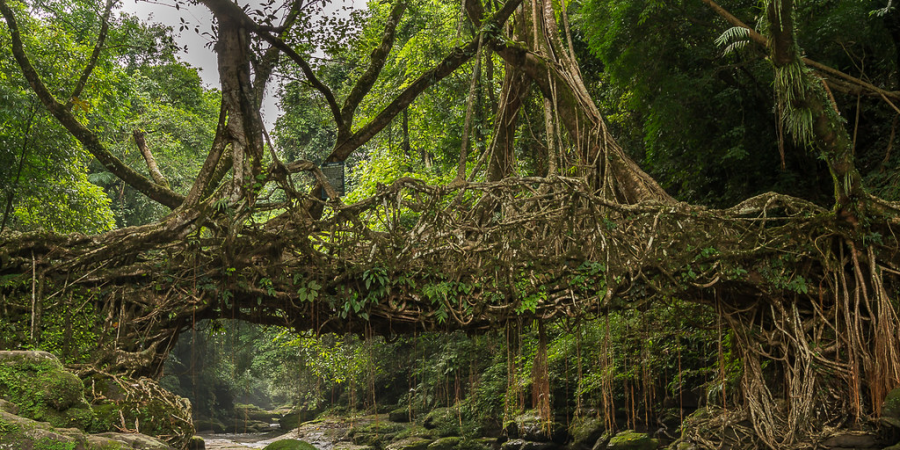

A type of tree shaping known as "living root bridges" involves constructing architecture out of ficus plant roots to span rivers. They "show a very wide variety of structural typologies, with various aspects of particular bridges resembling characteristics of suspension bridges, cable-stayed bridges, arches, trusses, and simply-supported beams," since they are constructed from live, growing trees. In the Indian state of Meghalaya, they are widespread.
Handcrafted by the Khasi and Jaiűtia people of the steep southern Shillong Plateau, the constructions are built from the aerial roots of rubber fig trees (Ficus elastica). The majority of the bridges are situated between 50 and 1,150 meters (160 and 3,770 feet) above sea level on steep hillsides covered with subtropical moist broadleaf forest.
Additionally, the Baduy people of Indonesia have built living root bridges in Jembatan akar on the island of Sumatra, in the state of Nagaland in India, and in the province of Banten in Java.
The roots of the bridge can naturally get thicker and stronger as long as the tree that gave rise to it is still in good health. Throughout the tree's life, new roots may appear; they must be controlled or clipped in order to reinforce the bridge. Some bridges have a lifespan of several hundred years and may support as many as fifty persons crossing them once they reach maturity. Many bridges have become useless due to corrosion or uncontrolled growth in the absence of proactive management. Up until the 2010s, there was little written record of live root bridges; nevertheless, in 2017, researchers geolocated 75 living root bridges.
By guiding the rubber fig tree's flexible roots across a stream or river and then letting them grow and develop over time until they are strong enough to support an adult human, a living root bridge is created. The new roots are frequently encouraged to unite by the process of inoculation, and they are occasionally bound or twisted together. It is easy to encourage the rubber fig tree's roots to take hold on the opposite sides of river banks because it is adapted to anchoring itself to steep slopes and rocky surfaces.
The functional life of any given live root bridge varies because they are composed of living, developing organisms. It is believed that a root bridge can endure for several hundred years in the right circumstances. Growing thicker component roots will naturally cause the bridge to self-renew and self-strengthen as long as the parent tree is still in good health.
